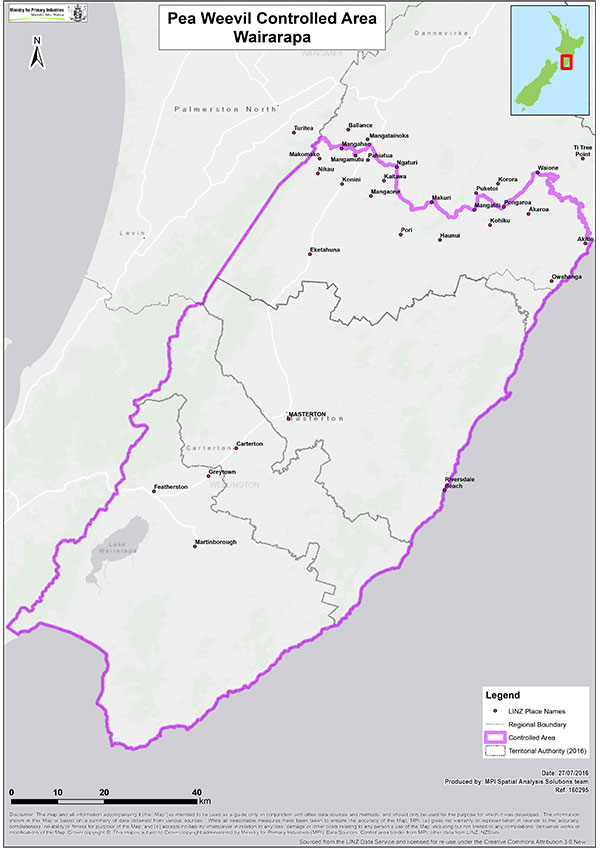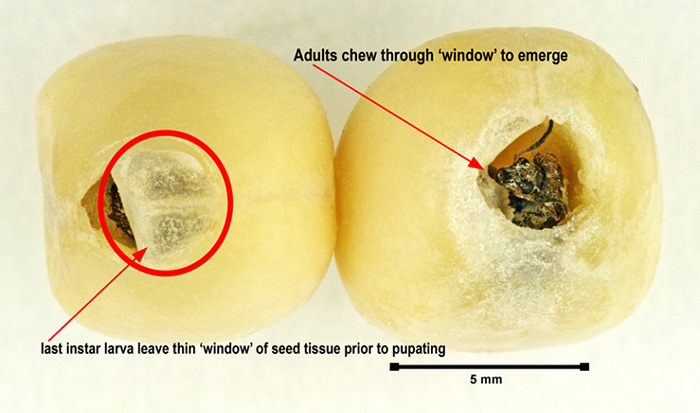Ban on growing peas in Wairarapa area
- From 4pm 27 July 2016 to July 2018, green and sugar snap peas cannot be grown in the Wairarapa area up to Pahiatua.
- This ban applies to both home vegetable gardens and commercial cropping.
- If you think you have found a pea weevil, catch it and call us on 0800 80 99 66.
Background
 If you see this pest, catch it and call us – 0800 80 99 66.
If you see this pest, catch it and call us – 0800 80 99 66.
The pea weevil ( Bruchus pisorum ) is a small insect that can cause damage to growing peas. It is an unwanted organism under the Biosecurity Act 1993.
Pea weevils have been found in the Wairarapa area of the lower North Island. If we don't stop them from spreading to other parts of New Zealand, they could have a serious effect on our pea growing and processing industries.
MPI is working with local growers to rid the Wairarapa of the pest by placing a 2-year ban on growing peas in the area. Pea weevil larvae only feed on peas so if we remove their food source, they'll die out.
What's being done?
MPI has issued a Controlled Area Notice (CAN) that indicates where peas can't be grown (all Wairarapa including Pahiatua) and restricts the movement of pea seed and pea straw within, and in and out of the area.
Map of the Controlled Area
 The Controlled Area covers all Wairarapa including Pahiatua.
The Controlled Area covers all Wairarapa including Pahiatua.
The ban will remove the weevil larvae's food source
MPI and growers are working together to rid the Wairarapa area of pea weevils. The 2-year ban on growing peas will remove the weevil larvae's food source, eventually causing the population to die out. MPI is also working closely with affected growers on options to reduce the financial impact of the ban – through finding alternative crops to grow in the next 2 years and through a support package.
Garden centres and shops will be asked to remove pea seed from shelves.
What you can and can't do
Inside the Controlled Area
If you live in the Wairarapa Controlled Area, you:
- can't plant or grow green garden or sugar snap peas in the Controlled Area
- can't move pea seed within or outside the Controlled Area
- can't move pea straw outside the Controlled Area (unless it has been fumigated – contact MPI for information)
- must destroy any existing pea plants or sprouting seedlings (pull out and compost, burn or feed to stock)
- must check areas where you have applied
not spreadpea straw mulch toonyour garden.property.If you findhave already spread mulch, you need to regularly check the areas forsprouting pea plants, removeplants. Removethese and either compost or put out with your household rubbish. (Note, locally produced pea straw will be ultimately be removed from sale in the Controlled Area) - should contact MPI if you believe you have found pea weevils.
If you live in the Wairarapa area you can:
- grow any vegetable crop other than peas or sugar snap peas
- use pea straw as stock feed provided the feed is provided in a trough or on a concrete surface
- apply any pea straw you have already purchased. But it is important that you check mulched areas for any sprouting pea seedlings and remove them.
- plant ornamental sweet peas (these are unaffected by pea weevils)
- eat fresh, frozen and canned peas (these are safe to eat and will still be available in stores in the Controlled Area)
- move frozen and canned peas out of the Controlled Area.
Thank you for complying with these restrictions. Your actions will help the Wairarapa’s pea farmers and will also protect the future health of your home grown peas.
Outside the Controlled Area
The ban on growing peas only applies in the Controlled Area. Outside this area gardeners can continue to use pea straw as mulch. It presents a very low risk of spreading the pea weevil. MPI has traced all pea straw from the affected farms and removed it. If you know that you have pea straw from the Wairarapa, you may want remove any sprouting pea plants from mulched areas and dispose of the plants in the compost or in your household rubbish.
Risk to New Zealand
There is a risk that pea weevils could spread from the Wairarapa area to other areas of New Zealand, which could have a serious effect on our export pea seed markets and the processed green pea industry. Weevils spread by flying from one site to another, and can also be moved in infected pea seed, straw or dirty farm machinery.
Pea weevil larvae feed on young peas, damaging crops. Larvae tunnel inside the peas, eating the contents as they mature. Pea weevils only affect green ripening peas, not dry peas, but the adults can remain hidden in grain for up to 2 years. Affected green peas can become foul and unfit to eat. Seed might still germinate but the seedlings are often weak and prone to disease.
By acting early, before the population spreads to other areas, we have a good chance of ridding New Zealand of the pea weevil.
Where in New Zealand?
So far, the pea weevil has been found in pea seeds grown on 8 different Wairarapa farms. It has also been found in seed stored at another 3 properties in the area.
Overseas, pea weevils are found in many regions, including the United Kingdom, Australia and North America.
What to look for
Pea weevils are small (4mm to 4.5mm long) insects, brownish-grey in colour with white flecks. The end of their abdomen has a white marking that looks a bit like an airplane.
They lay between 1 to 12 long, yellow eggs on the outside of pea pods. Eggs hatch in 1 to 3 weeks and the larvae then burrow into the pea.
Pea weevil larvae are up to 6mm long, white to cream in colour with a brown head.
 A thin window can be seen in affected seed before the adult emerges.
A thin window can be seen in affected seed before the adult emerges.
Who to contact
If you believe you have found pea weevils, call MPI on 0800 80 99 66.
If you have questions about pea weevils or the control measures:
- email info@mpi.govt.nz
- call 0800 80 99 66.